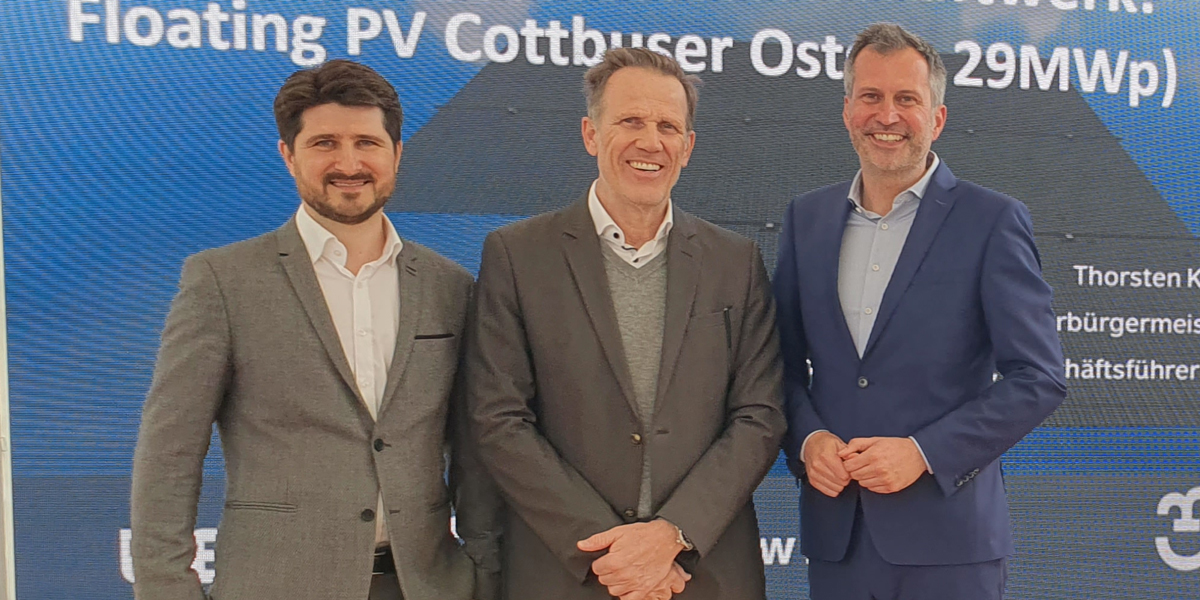The energy company LEAG, the project developer EPNE and the city of Cottbus have come one step closer to their goal of building a climate-neutral harbor district on the future Cottbus Ostsee with another construction stage for Germany's largest floating solar plant on a post-mining lake. To securely anchor the floating solar modules, the last of a total of 34 dolphins were rammed into the opencast mine floor, which will be compacted in the winter of 2021/2022, today in the presence of LEAG CEO Thorsten Kramer, Cottbus Mayor Tobias Schick, and EPNE Managing Director Dominique Guillou.
"Germany's largest floating solar plant on the largest post-mining lake represents the future use of the unique land potential of this region. This project consistently fits into our transformation project GigawattFactory, with which we want to transform Lusatia into a green powerhouse," says LEAG CEO Thorsten Kramer. "The plant is intended to become a starting point for further renewable projects in the area around the lake. With a combination of floating PV, wind power and lake thermal energy, Cottbus Ostsee is rising to become a model region for sustainable energy supply," Kramer said.
The Fraunhofer Institute confirmed enormous PV potentials of up to 2.74 GW for areas on mining lakes in former coalfields, even taking into account parallel use aspects. However, investment incentives would have to be created through innovation tenders, since the investment costs for floating solar plants are higher than for conventional PV ground-mounted systems. With the removal of regulatory hurdles, as well as the classification of open pit lakes as conversion areas in the EEG, the technology could contribute significantly to the expansion goals of the federal government.
Mayor Tobias Schick: "For me, what is essential for the transformation is: We don't just talk and debate, we act. We dare to do something new. And we do so together in the region. And so Cottbus/Chóśebuz remains the city of energy and Lusatia an energy region at the highest and most promising level. This is a pound of structural change that needs and will get a secure, stable and green supply of energy. The claim remains that all of this must remain affordable with a view to industry, companies and, not least, consumers. Anyone who dares to try something new will also make mistakes. But the first mistake would be to stop trying new things. Transformation and climate protection can only work together and in consensus on the path to a sustainable and climate-friendly future. Our lives will change, whether in terms of mobility or energy consumption. Ultimately, we gain quality of life and city life for all of us through such projects."
"In addition to its size and importance for the future Cottbus Ostsee region, the floating PV project is also a highlight from a project development perspective," emphasizes Dominique Guillou, Managing Director of EPNE. "The plant is built on the dry lake bottom and then floats up as the water level rises. This is unprecedented and the reason for the innovative anchoring system. The facility should fit in well with the overall appearance of the lake and also be in harmony with tourist use. We attached great importance to this during the planning phase. After two years of intensive planning and very good cooperation with all stakeholders, we are pleased that it is now entering the realization phase."
During the course of the project development, LEAG and EPNE were able to increase the output of the floating solar plant to 29 MW (previously 21 MW), bringing the annual electricity generation to 29,000 MWh. Electricity that can cover the annual consumption of about 8,250 households. At 16 hectares (about 22 soccer fields), the plant area will represent less than one percent of the lake's surface area, consistent with the lake's tourism use objectives. The floating PV system is scheduled to be commissioned in the second half of 2024.
The innovative mooring system based on driven-in dolphins is the technological highlight of the project. Dolphins are a proven technology for anchoring sea bridges, but they are being used for the first time in a floating PV project. The solar modules will be securely anchored to 15-meter-long steel tubes during and after the completion of flooding on the 1900-hectare lake.
The advantage of the method is the low-maintenance anchoring due to fewer necessary anchors and the elimination of a large number of anchor chains, which would have to be readjusted as the water level rises and falls. Around 51,000 solar modules on almost 1,900 floats will be attached to the 34 dolphins.
